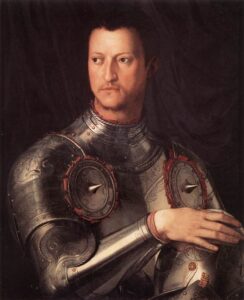
The origins of Uffizi Gallery
Indulge on a private tour of Uffizi Gallery, the Florence’s most famous museum and one of the most famous in the world, thanks to its Renaissance collection.
In 1560 Cosimo I de’ Medici decided to place the city’s administrative and judicial offices in a new building on the banks of the Arno. Uffizi means actually offices in old Italian. The plan was designed by Giorgio Vasari. He completed it a few years later with the addition of the corridor (The Vasari Corridor) connecting it to Pitti Palace, the Medici family’s residence. The Uffizi Gallery was designed to exalt the power of the monarch that had recently taken office in Palazzo Vecchio. In 1574, Francesco I, Cosimo I’s son, handed over the unfinished construction to Bernardo Buontalenti. Francesco I decided to designate the loggia on the top floor as his personal gallery. It had to keep his collection of 15th-century paintings, cameos, stones, jewelry, statues, bronzes, miniatures, scientific tools, and natural rarities.
A private tour of Uffizi Gallery and its collections

Between the 1500s and 1600s the Hall of Maps was dedicated to the maps of the domains of Florence, Siena, and Elba Island. The Stanzino delle Matematiche (Little Room of Mathematics) was created to conserve innovative scientific tools of the period. Vittoria della Rovere enriched the Gallery with splendid works of art by Titian, Piero della Francesca, Raphael, Federico Barocci, and others. She was the wife of Ferdinand II de’ Medici and the last descendent of the Dukes of Urbino.
Some of the most important acquisitions of the Gallery were part of Cosimo III’s collection, like the beautiful Flemish paintings (Rubens). The Gallery also housed works such as mummies and taxidermy animals. These aroused the curiosity of the monarchy and the intellectuals of the Renaissance.
At the end of the Medici dynasty, the Uffizi Gallery remained integral thanks to the bequest of the last heir Anna Maria Luisa to the Habsburg Lorraine. They became the new sovereignty of Tuscany. With the famous Family Pact, Anna Maria Luisa ordered the entire collection to remain intact and to never leave the city of Florence.
The Uffizi Gallery becomes a museum
The Lorenas were the ones to open the Uffizi Gallery to the public in 1789. They also reorganized the collections according to Enlightenment criteria, separating the major from the minor arts. Thus the armory, the majolicas, and the scientific tools were moved. The Gallery then gave privilege to the Italian paintings collection. In the 1800s the Uffizi was enriched with sculptures of illustrious characters placed under the loggia outside. The Uffizi was characterized more and more as a gallery of paintings. It actually saw the transfer of many sculptures to other museums. Collections from churches and religious institutions were also purchased. Today an addition to the Uffizi museum is being built. New installations are being planned. This will give the public a chance to admire the many precious works conserved in the building’s depository. Also, have you ever thought of taking a Jewish Tour at Uffizi Gallery, focusing particularly on Jewish subjects?
